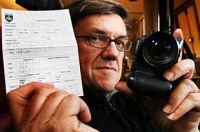You really have to wonder if there anyone with an ounce (gramme?) of Common Sense working in the upper levels of the police authority, as its ground troops seem to be out to do their best to sour relationships with the public, at a time – given the number of times its officers refer to terrorism – when it would seem to be a better idea to foster good public relations, and public cooperation. See also Police continue to abuse people with cameras.
The Terrorism Act 2000, and in particular Section 44, has raised its profile and drawn comment in here before, if for no other reason than I have been happily wandering around both town and countryside with camera in hand, taking photographs for no other reason than personal interest. It seems that this may not be sufficient or good reason.
I now genuinely fear that the following videos illustrate that this is no longer a valid reason to such a thing if representatives of the country’s police force are nearby. And I do use the term representatives deliberately, as it would seem that Police Community Support Officers (PCSO) like to use this as an excuse to harass people with cameras. PCSOs are not proper trained police officers, but they are given certain powers, and it seems that some authorities think their use is dubious at best. Although granted the power to use reasonable force, they can’t make an arrest – other than a Citizen’s arrest such as you or I might to – and give all the outward signs of Jobsworths, and maybe even straying into thugs (see the witnesses in the last video below if you think this is an extreme interpretation). I was brought up to question the suitability for anyone that actually volunteered for such a job, as opposed to someone properly trained and assigned (to it). While I think this is a gross oversimplification, I now think it’s also a valid concern, and granting volunteers significant powers seems to be a major mistake – such powers should only ever be granted to those who are trained, and have proven their competence to wield them.
To confuse things slightly, but remain correct, it should be noted that in Scotland, a PCSO is a Police Custody and Security Officer, a civilian employee of the Scottish police force. Most (but not all) of the accounts relating to this problem arise in England, often within the area controlled by the Metropolitan Police.
Photographers’ video reports
The first video was shot by a photographer who ended up spending eight hours in the cells after being stopped twice by PCSOs, then detained by a police officer the third time he was stopped and declined to give his details, on the basis that he believed there was no good reason for him to do so, and was told that his photography was antisocial behaviour. A fuller account of the incident appears in this article.
The second video shows first a plain clothed officer and then a uniformed police office trying to justify their demands after a private security guard called them when a photographer questioned him. The private security guard had been insisting that the photographer only point his camera at the upper floors of the building concerned, and not at the reception area or fire exits.
In the third video, we see an Italian student who was stopped by PCSOs, one of whom appeared to be chewing gum throughout. When she said she was “Filming for fun”, his response was not to believe her, and when thwarted in his attempts to extract details from the woman, decided to remember he had seen her cycle the wrong way in a street. Witnesses (a group of nearby workmen who can be heard shouting in the original video) later described how she had been forced to ground while being arrested and handcuffed, and that one officer involved deliberately used more than reasonable force. After five hours in a police cell, she was issued with an £80 fixed penalty for “Causing harassment, alarm and distress in a public place” – which she had to accept if she wanted to leave.
In all these cases, and probably most others, the suggestion that the individuals concerned are suspect terrorists is laughable, or would be if it did not show how incompetent the official were. In one case, the way the photographer was holding their camera was cited as justification for what amounted to “Stop and Search”, and that they were being intimidating.
What would a terrorist photographer look like?
After looking at these examples, you have to wonder what a genuine terrorist out to take photographs would look like.
Would they take pictures openly and close to their subject, like the individuals referred to here, and risk being accosted by the authorities as per these examples?
Or would they be more likely to visit a target subject or area carrying cameras with stabilised lenses that now offer anyone the ability to shoot pictures at zoom levels of X15 to X30 (and more with high megapixel CCDs and digital zooming or post-processing) with little or no camera shake or blurring, and mean that provided you have a clear view of the subject, can shoot from a distance that means anyone watching for “terrorists” is relatively unlikely to see you before you have your pictures, and make your escape… unmolested.
Videos
Video: Caught on camera: Lancashire police arrest amateur photographer | UK news | guardian.co.uk
Vodpod videos no longer available.
Video: A few photographs add up to a minor terror alert | UK news | guardian.co.uk
Vodpod videos no longer available.
‘You’re filming for fun? I don’t believe you’ | UK news | guardian.co.uk
Vodpod videos no longer available.
And finally…
A shocking excuse is offered to a 27-year-old female filmmaker, who tells how undercover police officers allegedly handcuffed her after she tried to film their colleagues using her mobile phone:
An inspector from the local police station telephones her months later to offer the excuse: “They didn’t know what they were doing.”
Video: ‘I felt totally helpless. I was being restrained’ | UK news | guardian.co.uk
Vodpod videos no longer available.
I wish it was finally, but I suspect that there will be more to follow.




 Thankfully, one of things that the Freedom of Information Act, and possibly the recent changes in policy that have seen Government data released into the public domain, is the fairly low incidence of problems between photographers and the law in Scotland, and the generalisation that this is largely an English problem, and one that can be further narrowed down to London town, and the Met Police.
Thankfully, one of things that the Freedom of Information Act, and possibly the recent changes in policy that have seen Government data released into the public domain, is the fairly low incidence of problems between photographers and the law in Scotland, and the generalisation that this is largely an English problem, and one that can be further narrowed down to London town, and the Met Police.
 Along with Northamptonshire County Council, Glasgow City Council leads a survey into local councils in Britain who can enter private property without requiring a warrant or police escort, having the most officers able to enter your home in this way, with almost 500 each.
Along with Northamptonshire County Council, Glasgow City Council leads a survey into local councils in Britain who can enter private property without requiring a warrant or police escort, having the most officers able to enter your home in this way, with almost 500 each.
 Students carrying out research at Berkeley University have published a paper entitled Flash Cookies and Privacy, which reveals the existence of Flash cookies – significant in that they exist outside the normal browser environment, are unaffected by the usual browser settings which control and delete cookies, and are all but invisible to the normal user, who will be unaware of their presence or purpose.
Students carrying out research at Berkeley University have published a paper entitled Flash Cookies and Privacy, which reveals the existence of Flash cookies – significant in that they exist outside the normal browser environment, are unaffected by the usual browser settings which control and delete cookies, and are all but invisible to the normal user, who will be unaware of their presence or purpose. The Regulation of Investigatory Powers Act (RIPA) allows public bodies such as the police to conduct surveillance in major crime-fighting and anti-terrorism cases, however it can also been used for surveillance by local authorities investigating such trivial problems as dog fouling and refuse collection. As a result, it seems the Government has now admitted that local authorities are abusing these powers and has ordered a review of the snooping law.
The Regulation of Investigatory Powers Act (RIPA) allows public bodies such as the police to conduct surveillance in major crime-fighting and anti-terrorism cases, however it can also been used for surveillance by local authorities investigating such trivial problems as dog fouling and refuse collection. As a result, it seems the Government has now admitted that local authorities are abusing these powers and has ordered a review of the snooping law.